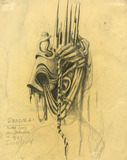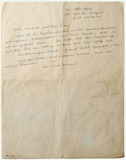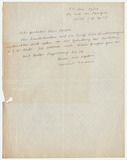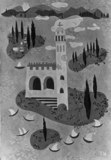Hans Sahl: Vincent, film script (undated)
The writer Hans Sahl worked in exile for several years, probably starting in 1937, on a biographical film about the painter Vincent Van Gogh, to whom he felt connected in his loneliness but also in his creative drive.In all the texts that Sahl composed for this project and all the letters that he wrote about it, one can clearly feel how close this idea was to his heart.
Hein Heckroth; drawing for Kurt Jooss’ ballet Pandora (1943)
An ornamental design for a mythical figureThe 26 January 1944 saw the premiere of Kurt Jooss' ballet Pandora in the Arts Theatre in Cambridge. The choreographer, who had emigrated in 1933, continued with the socially critical productions that had seen his greatest successes in the 1930s.
Heinrich Heine-Klub: Announcement of the premiere of Ferdinand Bruckner's Denn seine Zeit ist kurz (1944)
Ferdinand Bruckner's play Denn seine Zeit ist kurz received its world premiere by the Heinrich Heine Theater Klub on 30 September 1944 in the Teatro de los Electricistas in Mexico City. It was the most recent work of the Austrian playwright who emigrated in 1936 to the United States.
Heinrich Mann: Brief to Lou Albert-Lasard dated 24 February 1934
In this short letter written on 24 February 1934, the author Heinrich Mann, who was living in exile in France at the time, congratulated painter Lou Albert-Lassard on a lithography of hers he particularly liked. He also informed her about where Lion Feuchtwanger was living in Paris.
Heinrich Mann: La Haine / Der Haß (1933)
In his 1945 autobiography Ein Zeitalter wird besichtigt, Heinrich Mann poignantly and ironically describes the purpose of publishing his volume of essays, Der Haß, twelve years prior: “In 1933, the inaugural year of the thousand-year Reich, I lost no time in honouring it; today I could only make it longer, not add anything to it.” The collection of essays was published – just months after Mann's move into his French exile – by Paris-based publisher Gallimard.
Heinrich Mann: Letter to Rudolf Olden (20 January 1934)
German PEN, which had taken on a completely new direction after Hitler came to power, left the international association following the 11th International PEN Congress in Ragusa at the end of May 1933. On 28 December 1933, Lion Feuchtwanger, Ernst Toller, Rudolf Olden and Max Herrmann-Neisse issued a circular letter from London stating their intention of forming a new German PEN Group in exile.
Heinz Liepman: Das Vaterland, manuscript (1933)
Heinz Liepman's novel Das Vaterland was released in November 1933 by the Amsterdam publisher Kampen & Zoon. Liepman wrote the novel in France.
Heinz Liepman: Müssen wir wieder emigrieren? Manuscript extract (1963)
In his radio broadcast for Norddeutscher Rundfunk at the end of January 1963, the writer and journalist Heinz Liepman criticised the West German mentality which refused to confront its own Nazi past. Liepman regarded the everyday antisemitism which he encountered as less of a threat than the renewed resolve of those who permitted no criticism of the current social climate.
Heinz Trökes student ID card from Krefeld (summer semester 1940)
Immediately following the outbreak of World War Two, Heinz Trökes had to make a very difficult decision. He ended his exile in Switzerland and returned to Germany.
Heinz Trökes: Adriatische Landschaft mit 4 roten Inseln [Adriatic landscape with 4 red islands], painting (1938)
After completing his training under Johannes Itten in Krefeld, Heinz Trökes began working for a textile company in Augsburg. He liked this practical application of his skills, but still continued to draw and paint a lot at the same time.











